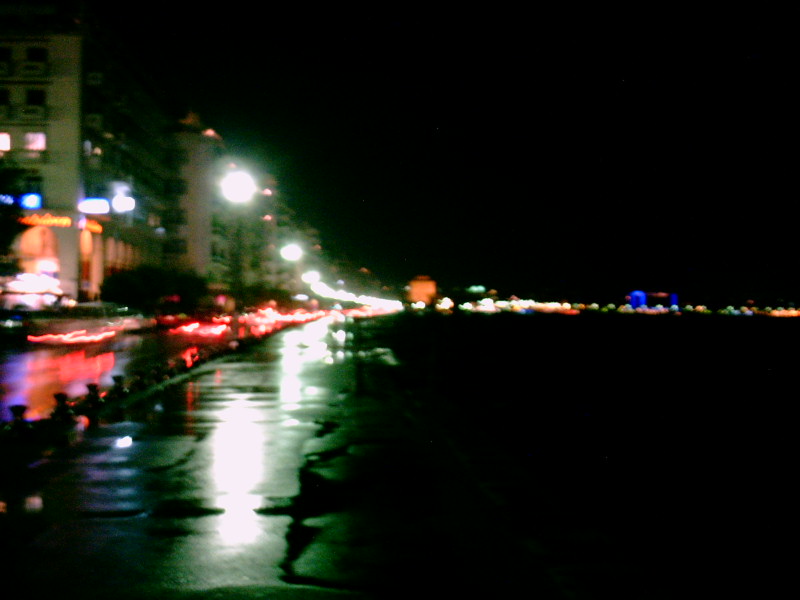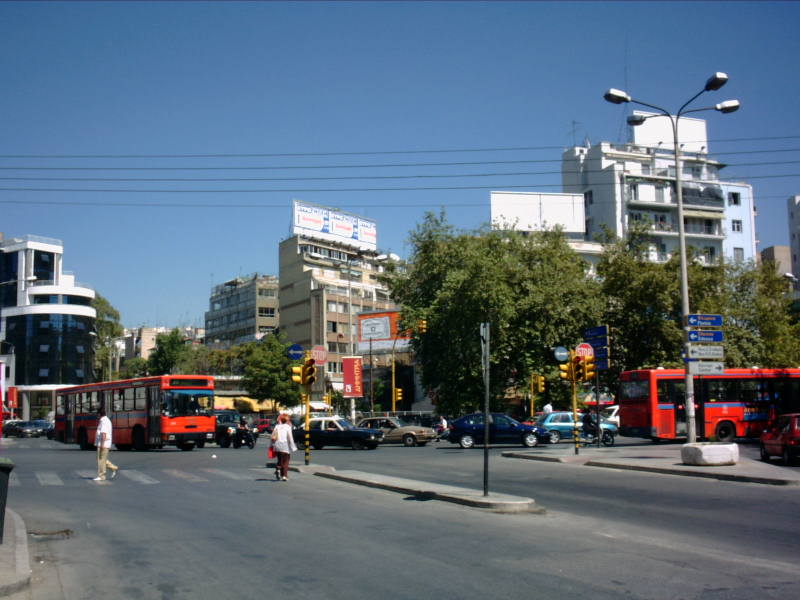|
Developed by Ali Emrouznejad |
| About Thessaloniki |
THESSALONIKI

When the king Kassandros of Macedonia founded Thessaloniki in 315 B.C. in the regional ancient suburb of Thermi, he chose to name it, after a very important person in his life, his spouse, and half sister of Great Alexandros. Thus began the history of a city that attracted international interest for more than 4.000 years.
Thessaloniki gains soon to be, the fame of “Mother of Macedonia” and takes over the nodal cloak of being the commercial center with connections to all ports of eastern regions developing at the same time a separate cultural identity.
In 279 B.C. it becomes the Roman capital of the Macedonia province, a “liberated city” at the duration of Roman season, uniting the east with the west through the Egnatia highway, which contributes catalytically in the growth of her prosperity.
At 50 a. c Apostle Pavlos visits Thessaloniki and founds the second Christian Church in the European continent that prepared and dispatched the eminent letters to the “people of Thessaloniki” who are considered up to date to the most important factors of Christian Faith. In the structure of the Byzantine Empire, Thessaloniki conquers the role of the second pole after Constantinople. This role bequeaths to her a Byzantine character that is maintained up until today, being the city with the most Byzantine monuments from any other. Her artistic, intellectual and religious influence affects catalytically the Balkan population.
The common capital of Byzantine Empire, the cradle of Christian Faith and Greek culture, changes Thessaloniki in to the “eye of Europe and particularly of Greece”.
During 1430 a . c it is taken over by the Turks of Mourat the second, and thousands of Thessaloniki citizens are slaughtered or driven to slave markets. Despite the intensity of the Turkish incision, Thessaloniki manages to maintain its ethical, moral and ethnical strength that it had inherited from her historical culture. Following the persecutions of Ferdinand and Isabella in Spain, thousands of Jews resort to Thessaloniki in 1492 and become cultural economic institutions expanding growth for the city.
In 1912 Thessaloniki is released by the Greek army, the day of feast of her protector, St. Dimitrios, and soon enters a new development orbit. In the passage of years it continued to accept blows that however shield her even in more. In 1917, a large fire demolishes the center of the city leaving behind incalculable damage and thousands of homeless citizens.
A few years later, in 1925, the International Trade Fair is founded in the city, as well as the University of Thessaloniki that symbolize her developmental course. In 1966 Thessaloniki is revived by the feast of St. Dimitrios, while in 1978 a powerful earthquake convulses the city bringing down catastrophic consequences. A very important station in the historical contribution of Thessaloniki constitutes in 1997, when it is being nominated as a cultural capital of Europe and is called to give a sample of her rich cultural heritage.
A tour in the city reveals at first glance her historical past, the fortification of the city with its 6 towers, where the White Tower is on first plan, strongly symbolizing Thessaloniki and all of its rich historical culture.
Contemporary Thessaloniki is a city very open and ready to satisfy even her most exigent visitors. A city that beyond her historical identity remaining alive, adapted in the modern tendencies, with the shuddering existence personalized by the thousand of young individuals attending the two University Institutions.
|
Thessaloniki Main Attractions |
|
White Tower

|
Nikis Avenue, Thessaloniki
The White Tower once stood with many others, surrounding the medieval city, until the Ottoman Turks destroyed all but two in 1866. Constructed in the 15th century this tower served as a defensive bulwark, an infamous prison, a place of execution, and now is home to a wonderful collection of sculptures, frescoes, and other interesting artefacts from 300 to 1400 AD portraying the amazing history and culture of the city. The White Tower, once known as the Bloody Tower, has become the city's most famous landmark. |
Archeological Museum of Thessaloniki
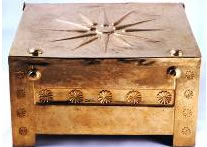
|
Hanth Square 6, M. Andronikou Street, Thessaloniki
With a wonderful collection of artifacts from Neolithic times and amazing sculptures from the Archaic to the Late Roman period, this museum is a house of treasures. There are many thematic units that are very significant, and which provide a thorough and unforgettable exhibition of the history of Thessaloniki and the surrounding areas. |
Aghia Sofia
 |
Pavlou Mela Street, Aghia Sofia Square, Thessaloniki
Built in the 8th century, Aghia Sofia is a beautiful Christian church modeled on the magnificent church of Aghia Sofia in Istanbul. The church contains superb mosaics and wall paintings including a wonderful mosaic of The Ascension. |
Byzantine Museum
 |
2 Stratou Avenue, Thessaloniki
Containing the finest collection of Byzantine art in Greece, this museum focuses on preserving, researching, and studying the remains of the Byzantine civilization. The treasures housed in this fine museum include priceless icons, frescoes, sculpted reliefs, mosaics, jewellery, manuscripts, and pottery. |
Rotonda

|
Dimitriou Gounari Street, Thessaloniki
This monument was built in 306 AD as the mausoleum of the Roman Emperor Galerius. Later the Rotonda became a church dedicated to St. George and wonderful 4th century mosaics were added. After serving as a mosque for the Ottomans, the Rotunda now houses Christian art and occasionally holds art exhibitions and concerts. |
Aghios Dimitrios
 |
Aghiou Dimitriou and Aghiou Nikolaou at Egnatias Street, Thessaloniki
After the great fire of 1918 the church was restored with the aim of preserving the details of the original. Originally the church was built on the ruins of a Roman bath. Beneath the church is the crypt of the martyr Aghios Demetrios containing sculpture from the 3rd to 5th centuries and Byzantine artifacts. |
The Arch of Galerius
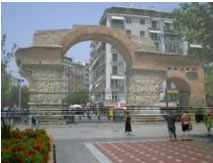 |
Egnatia Odos, Sintrivaniou Square, Thessaloniki
To celebrate Galerius' victory over the Persians in 297 AD, this archway was built in 305 AD and reliefs were sculpted onto the surfaces of the arch depicting scenes from the battle. |
Modiano Market
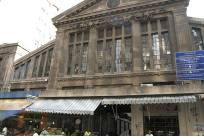 |
Ermou (South Side), Thessaloniki, Greece
Here, one can not only shop, but eat, drink, listen to the music provided by gypsy musicians and enjoy the culture and diverse crowd visiting the open-air market. |
| |
|
Most important Museums of Thessaloniki |
|
The White Tower Thessaloniki
New exhibition at the monument-
symbol of the city
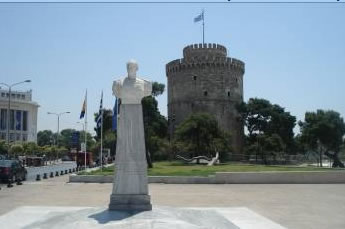 |
The new permanent exhibition at the White Tower, dedicated to the city of Thessaloniki and housed in the monument-symbol of the city, opened its doors to the public.
The exhibition, organized by the Museum of Byzantine Culture, presents aspects of the history of Thessaloniki through time, thus providing the visitors with a better insight of the city, its monuments and museums. The goal of the exhibition is not to turn the city into a museum, but to introduce it to its visitors and its citizens, creating a new and essential relationship between the people and the city.
The new museum aims at becoming the starting point for a tour of Thessaloniki, without, however, undermining other museums. Additionally, from a museographic point of view, the exhibition's design fully respects the monument's unique architectural identity. Therefore, the exhibition neither competes with nor hides the monument; on the contrary, it reveals and stresses its beauty.
|
Visiting the exhibition
The idiomorphic and special internal arrangement of the Tower did not allow the realization of necessary interventions, in order for the White Tower to have the basic infrastructure of a modern museum building. Therefore, the exhibition does not provide air conditioning, toilets for the visitors, cafeteria and cloakroom. Due to the fact that the installation of a lift was also impossible, people with disabilities shall have the opportunity to visit the exhibition only virtually, through information points at the ground floor of the building. The need to maintain stable temperature conditions and the limited resistance of the monument have necessitated a strict visitor flow control, based on international practices. According to a special study, the number of visitors entering the monument and visiting the exhibition shall not exceed 70, so as to sustain the required temperature and humidity conditions. Therefore, organized group visits (schools, groups) will be possible only through a booking procedure. The White Tower exhibition will be open from Tuesday to Sunday, from 08.30 to 15.00. |
The Thessaloniki Archaeological Museum
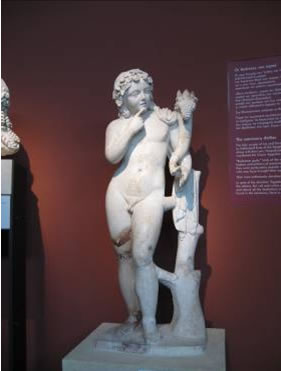 |
Just reopened in July of 2006 after a three-year renovation, this dazzling collection is a must-see for visitors to Greece's "northern capital" of Thessaloniki.
A new exhibit showing a plait of hair and rich grave clothes from a young woman's burial; many gold artifacts from Alexander-era tombs; tomb reconstructions.
Usual Museum Hours:
Monday 10:30 - 3:00
Tuesday-Friday 8:30-3:00
During Summer: Open Saturday and Sunday, 8:30-3:00
Recently, Greek authorities have been extending posted hours of some key attractions during peak tourist periods. These additional hours are usually not noted on the websites and travel agents and hotel desk clerks may not know about them. Don't decide that you can't go until you directly verify that the museum is really not open the hours you need that day.
Thessaloniki Archaeological Museum Address:
6 Manoli Andronikou
Telephone: From the US: (011) 30 231 0830538
Email: istepka@culture.gr
Official Thessaloniki Archaeological Museum Website: http://www.amth.gr/ |
Thessaloniki Olympic Museum
 |
The Sports Museum was established in Thessaloniki in 1998 with the support of the Ministry of Culture, the Ministry of Macedonia – Thrace, the Special Secretariat for Sports, Athletic Unions and Associations of Local Authorities. In 2001, the Museum transformed into a non-profit private institution, named “SPORT MUSEUM of THESSALONIKI”. In January 2008, the International Olympic Committee recognized the Museum as the first Olympic Museum of the country, with the name THESSALONIKI OLYMPIC MUSEUM. The supreme honor of the recognition of the Museum’s work and offer to the public of Central and North Greece was the turning point of the Museum’s entrance in its second decade.
The restricted faculty of its first domicile, at Aristotelous Square, was surpassed in the new privately owned building in the conflict of Agiou Dimitriou str and 3r September str.
The new building integrates in an urban knot of special sport, educational and cultural significance, while the structure of the building offers the possibility of multiple way of use, since it includes a fully equipped amphitheatre, two multiple-use halls, a buffet bar and shop.
The missions of the Museum are the conservation, promotion, information and innervation of the public in the issues of sport heritage, and also the communication and co-operation with agencies of the athletic family. In this frame was developed the exhibition movement of the Sports Museum, that was accompanied by publications, museological educational programs and parallel events.
Official Thessaloniki Olympic Museum website:
http://www.olympicmuseum-thessaloniki.org/ |
Museum of Byzantine Culture

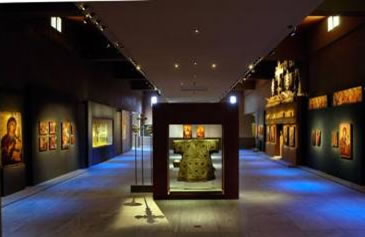
|
The Museum of Byzantine Culture aims in presenting various aspects of life during the byzantine and post-byzantine periods: art, ideology, social structure and religion, as well as how historical changes and the political situation were affecting people' s everyday life.
At the same time, the activity of the Department of Educational Programmes, the good structure and function of the conservation laboratories and of the archaeological material storerooms, the provision of scientific know-how to other Balkan countries, the organisation of scientific meetings and conferences, as well as the editing and publishing work, render the Museum into an exceptionally important centre for the preservation, research and promotion of Byzantine and Postbyzantine culture. Since the Museum' s inauguration in 1994, an annual bulletin is published, the first of its kind by a Greek public museum.
The Museum of Byzantine Culture was awarded the Council of Europe Museum Prize for 2005, following the concurrent recommendation of the Council' s Committee for Culture, Science and Education.
The founding of the Museum of Byzantine Culture and its official opening in 1994 in Thessaloniki, the most "Byzantine" city of the modern Greek state, marks the end of a story that had begun long before, just after the city' s liberation in 1912.
In August 1913, a decree issued by the Governor General of Macedonia, Stephanos Dragoumis, resolved to establish a "Central Byzantine Museum" in Thessaloniki. At the suggestion of the Metropolitan of Thessaloniki, Gennadios, it was decided that it would be housed in Acheiropoietos Church. The decision was never carried out, however. Instead of Acheiropoietos, a government decree issued in 1917 appointed the Rotunda as the new Macedonian museum, and large numbers of Christian sculptures were collected.
|
there, some of them remaining on display in the Rotunda until the earthquake of 1978. Meanwhile, the Christian and Byzantine Museum was founded in Athens in 1914, and in 1916 antiquities were transferred en masse from Thessaloniki to Athens "for their own protection" and eventually included in the collection of the Byzantine Museum in Athens.
The question of founding the Museum resurfaced in actuality after the change of polity in 1975. In 1977 a nationwide architectural competition was announced and it was won by the entry submitted by Kyriakos Krokos.
The foundation stone was laid in March 1989 and the building was completed and handed over in October 1993. The antiquities that had been transferred to Athens in 1916 returned in June 1994, part of which was displayed in the museum' s inaugural exhibition, "Byzantine Treasures of Thessaloniki: The Return Journey", which opened, together with the museum, on 11 September 1994.
The 11 rooms that comprise the Museum' s permanent exhibition opened gradually to the public from 1997 to early 2004.
Since 1997 the Museum of Byzantine Culture has had the status of an independent regional unit of the Ministry of Culture with its own director.
Museum of Byzantine Culture
2 Stratou Avenue, Thessaloniki 546 40, Greece
P.O.B. 50047, Postcode: 54013 Thessaloniki
Tel:. +30 2313 306 400
Fax: +30 2310 838 597
Monday: 10:30 - 17:00
Tuesday - Sunday: 08:00 - 15:00 |
|
|



 DEAsoftware.co.uk
DEAsoftware.co.uk










